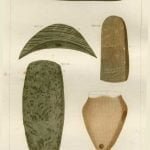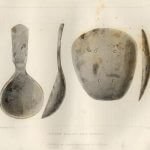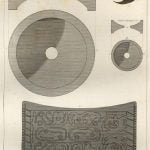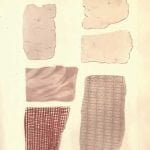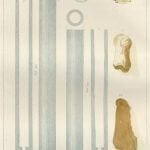There was found, on opening some of the minor mounds of the Ohio Valley, a species of tubes, carved out of steatite, which attracted attention. These tubes appeared to have been bored by some instrument possessing a degree of hardness superior to steatite. One end was entirely open; the other had a small aperture, as if it had been intended to facilitate suction, by a temporary rod and valve. Specimens of these are figured in Plate 32, Figs. 5, 6, 7, 8, 9, 10, 11, 12.
The same district of country disclosed, by its tumuli, large masses of the silvery kind of mica, which may, from its small perforations, have been designed for ornamenting ancient costume. See Plate 30, Figs. 1, 2, 3. Other mounds of the same region contained a very thick and heavy species of pottery, which seemed, from its fragments, to have been employed for saline kettles, or some metallurgic operation. (See Plate 34, Figs. 2 and 3.)
A singular species of amulet, apparently, was used by the Potomac tribes; see Plate 16, Fig. 6, which is drawn from a specimen in the National Institute.
Hollow bones of birds were employed for a species of baldric by the ancient Indians. They were of various lengths, reaching to three inches, and were bound around the body by a cord passing through them. (SeePlate 33, Figures 3, 4, 5.) These articles were taken from the ossuaries at Beverly, in Canada.
In the same location were deposited what appear to have been walking-canes, having the twist of a vine about them, and domestic utensils of wood; all of which are, however, now completely mineralized. (See Plate 33, Figures 1 and 2; and Plate 19, Figures 1 and 2.)
In some of the low mounds of Florida were discovered the fragments of an utensil, the purpose of which appears to have been the preparation of some liquid, or drink, which required to be ceremonially poured out, without the possibility of the contents being spilled and lost. (See Plate 34, Figure 1.)
Local Manitoes. The superstitions of the existing race of Indians are evinced by their frequently selecting curiously wrought boulders of rock, called Shin-ga-bawas-sins by the Algonquins. These boulders have the essential character of idols. They mark the supposed locality of some god of the air. They are sometimes distinguished by the use of pigments. (See Plate 12, Figure 4, 5, 6, 7, 8.) They are generally imitative water-worn masses, upon which no chisel or labor of any kind has been employed, except by the addition of Indian pigments. Plate 74 is supposed to represent the Gitchy Kenabec, or Great Serpent, of their mythological and allegorical fictions.
Figures 6 and 7, Plate 33, represent an antique implement of pottery, with a singular rugose mouth, of which it is not easy to form a definite opinion.
Figure 6, Plate 23, represents a curious antique, the use of which has puzzled conjecture, found in a tumulus in the Ohio Valley. It is formed from a very hard and compact species of slate-coal, and the material differs only, in this respect, from the common product of the Pittsburg coal-basin.
Figure 3, Plate 11, appears to have been a coal-chisel.
Figure 5, of the same plate, is manifestly a form of antique pipe.
In Figures 2 and 3, Plate 21, we behold two drawings, in two positions, of a large and well-made copper chisel, found in 1828 in a grave in the Straits of St. Mary’s, which connect Lake Superior with Lake Huron. Its manufacture from the native copper, which is now being so extensively explored in the basin of the former lake, cannot be questioned.

